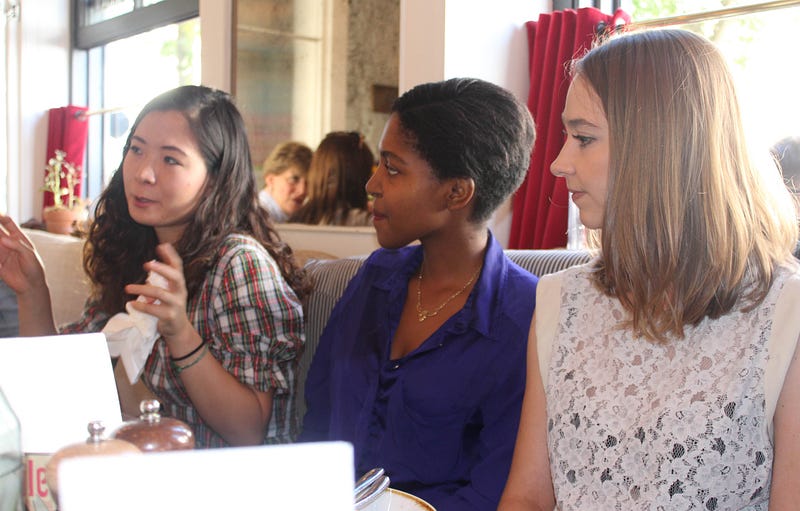How I built a global tech community and company with zero code

“I love tech, but I’m not a techie” is a phrase I’ve heard from countless people, particularly women, since starting Hustle Crew in 2016. I shake my head every time because even though I have worked in tech for almost a decade at giants like Amazon and Groupon, I never once wrote a line of code in any of those roles. What does it mean to be techie anyway?
I found myself in summer 2016 unemployed with no next move planned. I quit my job in a London based startup because I was fed up with a lot of stuff, not only the role but the way I saw the tech scene going. On the one hand, all of us are becoming increasingly dependent on tech and AI is on the rise. On the other hand, the teams creating innovative tech like AI remain a pretty homogenous bunch of people I don’t identify with. I decided to do something about it.
I looked back on my own career journey and realized that there is a lot about navigating the career world, and tech careers in particular, that I wasn’t taught at school or university. Valuable lessons about personal branding, interviewing and negotiating are some of the missing elements causing a shortage of women and other underrepresented groups in tech. Universities cater to traditional corporate roles, so the only grads who find themselves in tech do so by virtue of their network or sheer luck and tenacity. I want to change that.
The first step was to write a careers advice book with all the lessons I learned in the real world after graduating, but surely there could be a more scalable solution? My friend Natalie suggested testing my book’s theories with the target audience, so we launched a series of careers workshops for millennials — especially women — interested in furthering their tech / digital careers. The feedback was so positive we knew we were onto something; the lightbulb went off. We could capitalize on this success by building a platform, Hustle Crew, where women could continue learning, share advice and connections and move forward with their career goals. Dream big and hustle hard on a global level. But how to build it?

Initial ideas sketched out, fuelled by tea, toast, and chocolate
One weekend in August we camped out in my lounge, MacBooks open, ready to start building in Rails. We sketched out our wireframes and started hacking away at the basics. Natalie is a more advanced coder than me, so I was still watching video tutorials from Mackenzie Child while she started setting up GitHub repositories. An hour in, we decided to scale back our MVP asking ourselves, “What features do we really need to turn our vision into reality?” We started listing them out. We needed an online storefront to broadcast our mission and offering, a way to let people sign up to our mailing list for updates, a way for members to download careers resources we had created and a way for members to book onto our events. Another question arose, “Did we really need to create our own stack from scratch for all that?” Of course not.
We decided to use Squarespace for our MVP. The initial business model was B2C subscription — we offered weekly careers coaching calls from £40 a month to ambitious millennial women seeking to further their tech careers. The first technical challenge was how to create a members-only section behind a subscription paywall using SquareSpace. Through Google search, we stumbled upon a SaaS company called GoPaywall. They offer a plug-in that lets you turn your Squarespace site into a membership site. All I had to do was basic JavaScript which their documentation explained clearly. I was even able to get 1:1 help from their support team when my scripts didn’t load properly the first time. It was like magic — with one simple plug-in, we had launched our first tech platform product.

Debating the future of tech at a Hustle Crew brunch club
We set up Stripe for accepting payments and received a discount on processing fees via my friend who works there. We sent out an email campaign notifying workshop attendees of our launch and converted a dozen of them into paying customers. The revenue started flowing in. We were invited to join The Family — a sort of incubator meets accelerator meets tech collective. Hustle Crew was still just a SquareSpace site. MailChimp handled the CRM and Buffer helped with managing content on Twitter, Facebook, and Instagram. With each passing day as we published content to our site like Hustle Crew hero interviews with fearless women in tech, and shared photos from past events on social channels, we watched our community grow into the hundreds. Its now over 1,000 members spread across the world.
During the first few months in the incubator in winter 2016, things changed a lot. Natalie decided to focus on her studies full time which meant I lost my fellow visionary, my co-founder. The business model changed, too. Scaling a B2C business while bootstrapping meant MRR was nothing like the hockey stick growth we dream of when aiming for VC funding. With advice from The Family, I pivoted to a more sustainable B2B model and started offering inclusion training initiatives to tech companies who wanted to be more productive. I decided to give everything to the community for free, a decision that enabled unrestricted growth and meant Hustle Crew was now more aligned with my vision to help those with fewer advantages than tech’s status quo.

Me waiting to start the first workshop in July 2016, it’s surreal to think I’ve delivered close to 100 since then!
Now as Hustle Crew approaches its second birthday I reflect on what I’ve been able to achieve with my no code tech product. I’ve helped hundreds of women break into tech through education and networking, plus further their careers and entrepreneurial ambitions by connecting them to mentors. I’ve helped hundreds of undergrads navigate the intimidating startup landscape and secure exciting roles.
I’ve worked with tech companies from Berlin to Silicon Valley to help them build more inclusive cultures and attract and retain more women into their teams. Most importantly I’ve been able to put a price on this work, generating revenue and creating real value in people’s lives. Whether its sales of my book or selling a workshop, my no code site has served me very well. My measure of success is seeing more people like me making things happen in tech — for tech teams to represent society as the industry transforms our daily lives. So, what does it mean to be techie anyway?
Originally posted here. Find Abadesi on twitter



